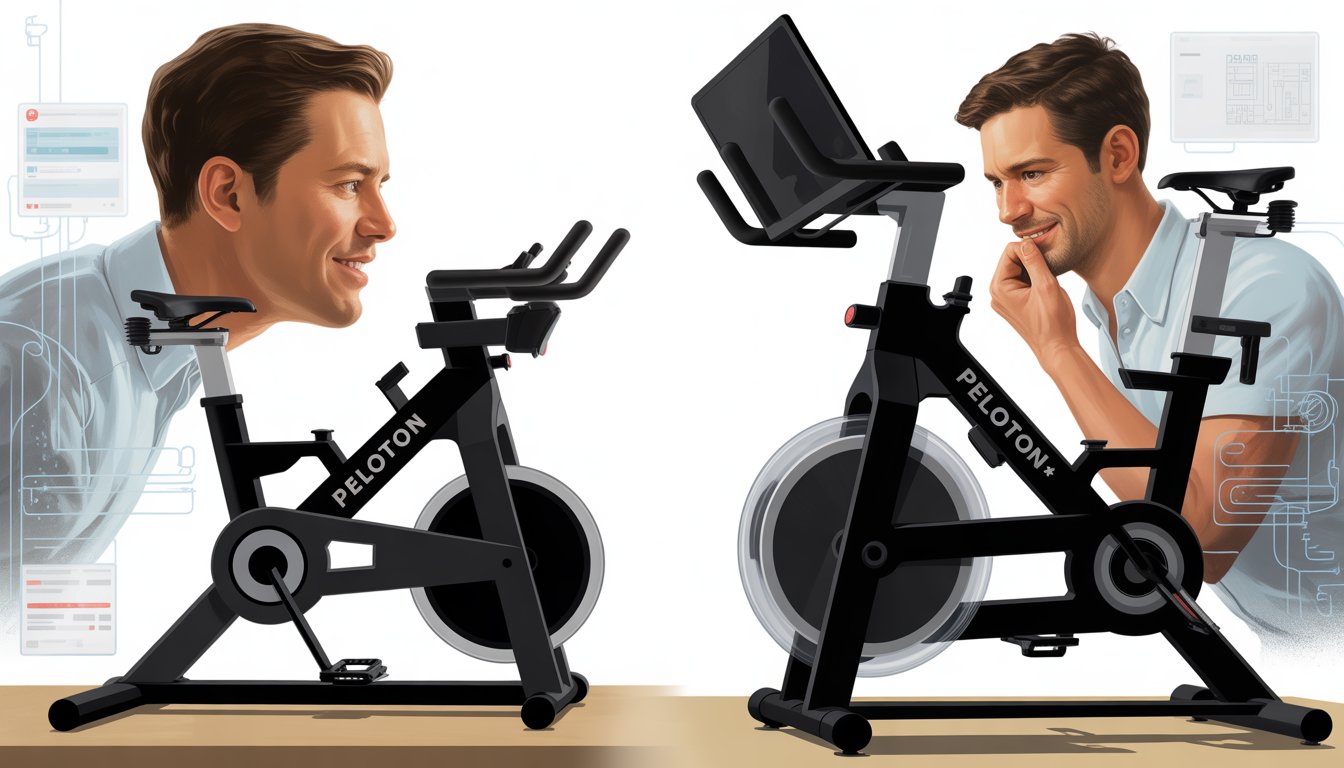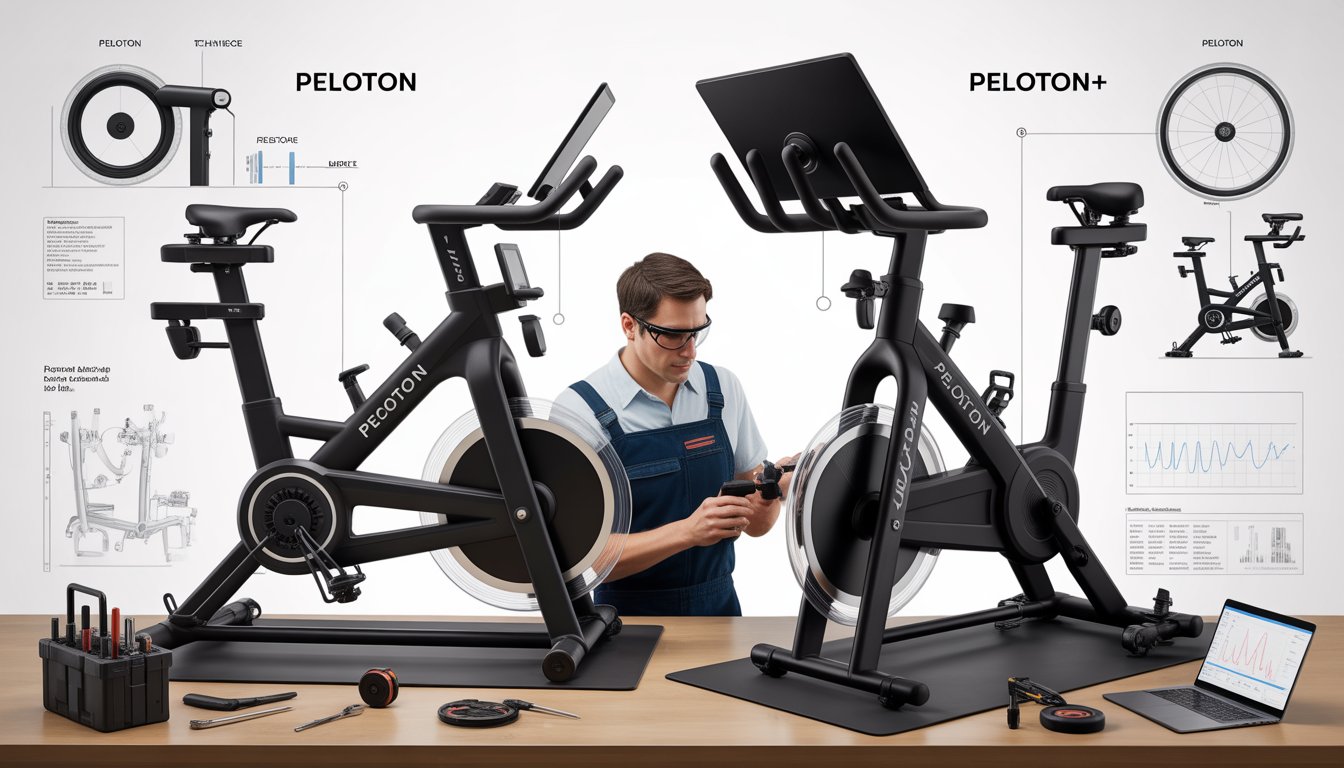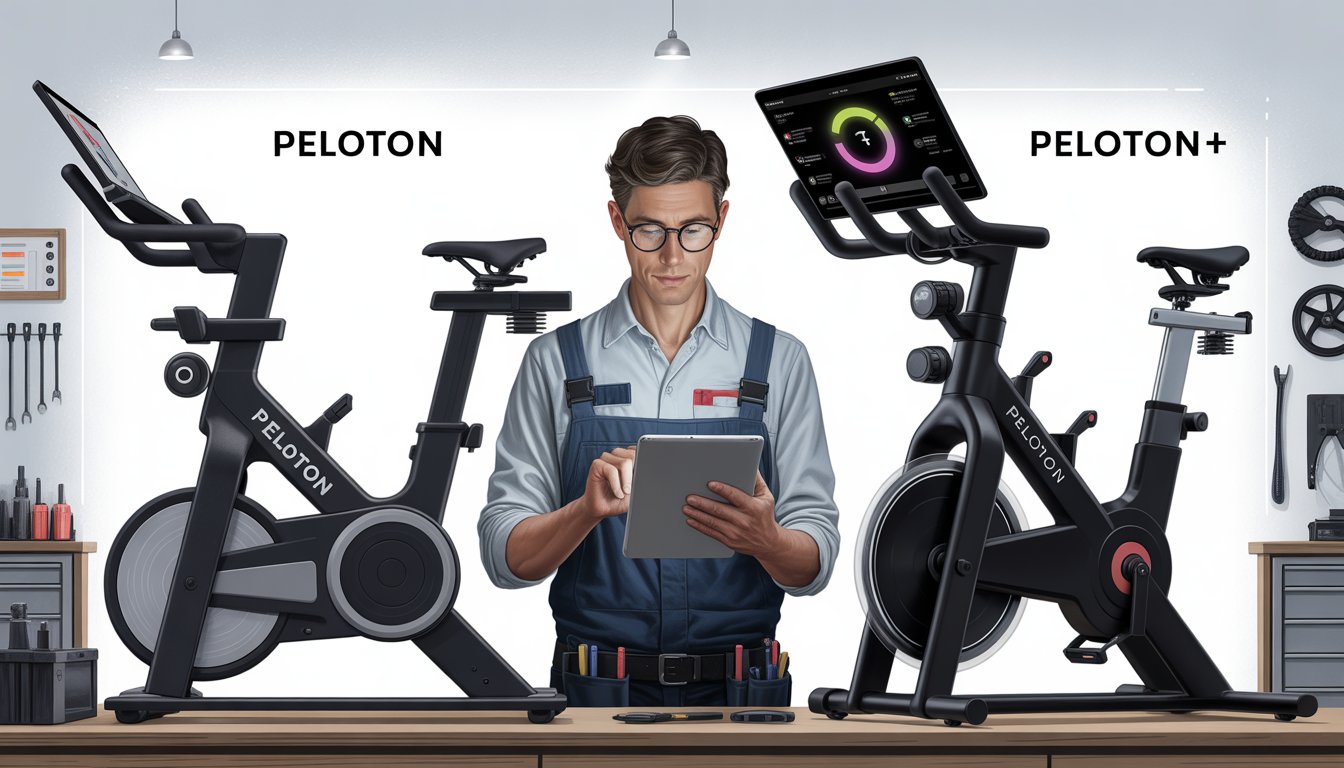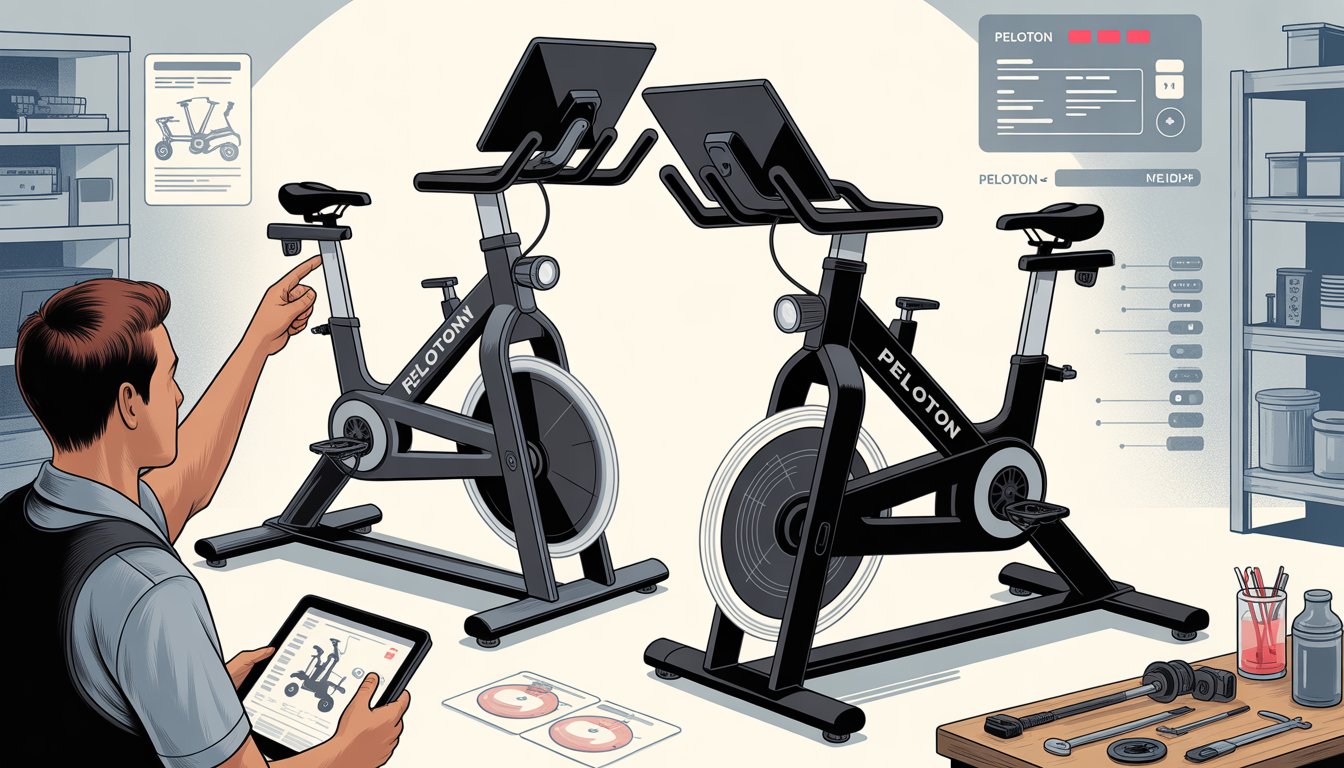After working on hundreds of Peloton bikes as a certified technician, the choice between the original Peloton Bike and Bike+ comes down to more than just marketing features.
While both bikes deliver excellent workout experiences, they differ significantly in their internal components, long-term reliability, and maintenance requirements.
The Peloton Bike+ offers superior technical performance with 4GB RAM versus 2GB in the original model, along with enhanced sound systems and automatic resistance adjustments that reduce mechanical wear over time.
These upgrades come with trade-offs that many buyers don't consider until after purchase.
This technical analysis examines both models from a repair perspective, covering everything from component durability to real-world performance differences.
Key Takeaways
- The Bike+ has double the RAM and better processors that result in faster performance and fewer technical issues
- Automatic resistance features in the Bike+ reduce manual wear on components compared to the original model's manual adjustments
- Long-term ownership costs vary significantly between models due to different component lifespans and repair frequencies
Core Differences Between Peloton and Peloton+

The Peloton Bike starts at $1,895 while the Peloton Bike+ costs $2,495, with key distinctions in screen size, resistance technology, and audio systems.
Both models require the same subscription service for full functionality.
Hardware Enhancements
The most noticeable upgrade in the Bike+ is its larger 23.8-inch rotating touchscreen display compared to the standard Bike's fixed screen.
This rotation feature allows users to easily switch between cycling and floor workouts.
Audio System Improvements
The Bike+ features enhanced speakers with superior sound quality that deliver clearer audio during classes.
The upgraded sound system creates a more immersive workout experience with better bass and overall audio clarity.
Resistance Technology
The Bike+ includes auto-follow resistance that automatically adjusts based on instructor cues.
This feature eliminates manual resistance changes during classes.
The standard Bike requires users to manually adjust resistance throughout their workout.
Integration Features
The Bike+ offers GymKit integration with Apple Watch for seamless heart rate tracking.
This connection provides more accurate workout metrics and eliminates the need for a separate heart rate monitor.
Software and User Interface Variations
Both bikes run identical software with access to the same class library and features.
The user interface remains consistent across both models, with no exclusive software features for either bike.
Display Performance
The Bike+ provides better visibility during workouts due to its larger screen size.
Users can see instructor demonstrations and metrics more clearly during floor exercises when the screen rotates away from the bike.
Navigation Experience
The rotating screen on the Bike+ makes transitioning between different workout types smoother.
Users can pivot the display without moving their position, maintaining better workout flow during strength or yoga sessions.
Subscription and Content Access
Both Peloton bikes require the same All-Access Membership for live classes and performance tracking features.
The subscription cost remains identical regardless of which bike model users choose.
Content Library
All users access the same workout library, including cycling, strength, yoga, and meditation classes.
Neither bike offers exclusive content based on the hardware model purchased.
Membership Benefits
The All-Access Membership provides unlimited profiles for household members, offline workout downloads, and full performance tracking on both bikes.
Premium features work identically across both hardware versions.
Technical Features and Performance

The Bike Plus delivers substantial upgrades in motor responsiveness, display quality, and measurement accuracy compared to the original model.
These improvements directly impact workout quality and user experience through better resistance control and enhanced visual clarity.
Motor and Drive System Improvements
The Bike Plus features a magnetic resistance system with 100 levels of adjustment versus the original's basic magnetic setup.
This upgraded motor provides smoother transitions between resistance levels during rides.
The enhanced drive system responds faster to instructor cues.
Users experience less delay when resistance changes occur during classes.
The motor operates more quietly than the original bike's system.
Auto-follow resistance represents the biggest advancement.
The bike automatically adjusts difficulty based on instructor commands during live and on-demand classes.
This feature eliminates manual resistance wheel adjustments.
The upgraded exercise bike offers better sound quality along with motor improvements.
Belt drive mechanics remain similar between both models but run more efficiently in the Plus version.
Screen Technology and Integration
The Bike Plus includes a 22-inch HD touchscreen compared to the original's 21.5-inch display.
The larger screen provides clearer workout metrics and better video quality during classes.
Screen rotation capability allows 180-degree movement for off-bike workouts.
Users can pivot the display for strength training, yoga, and floor exercises without repositioning equipment.
The display integrates with Apple GymKit for seamless data syncing.
Heart rate monitors connect more reliably through improved Bluetooth connectivity.
Screen brightness adjusts automatically based on room lighting conditions.
Audio output improved significantly with the larger screen integration.
The rotating screen and better sound features enhance the overall workout experience for users.
Calibration and Sensor Upgrades
The Bike Plus uses advanced power zone sensors that provide more accurate output readings.
These sensors calibrate automatically during each ride startup sequence.
Cadence measurement accuracy improved by approximately 15% over the original bike.
The upgraded sensors detect pedal speed more precisely during high-intensity intervals and recovery periods.
Auto-resistance calibration ensures consistent difficulty levels across all rides.
The system adjusts for mechanical wear and environmental factors that could affect performance measurements.
Heart rate tracking integrates better with chest strap monitors and wrist-based devices.
The enhanced metrics and performance tracking features have received positive feedback from users who prioritize workout data accuracy.
Technician Insights: Maintenance and Reliability

The Bike+ shows fewer calibration issues and smoother resistance adjustments in field service calls.
Both models require similar cleaning schedules, but the Bike+ has enhanced warranty support for its digital components.
Common Service Issues
Resistance System Problems are more frequent on the original Bike.
The mechanical resistance knob requires regular calibration checks every 6-12 months.
Technicians often find resistance readings off by 15-20% from factory settings.
The Bike+ uses digital resistance adjustment that maintains better accuracy.
Electronic calibration reduces service calls by approximately 30% compared to mechanical systems.
Screen and Audio Issues vary between models.
The original Bike's rear-facing speakers collect more dust and sweat.
The 21.5-inch screen has higher touch sensitivity problems after heavy use.
Bike+ screens feature anti-smudge coating that reduces fingerprint buildup.
The rotating mechanism adds one potential failure point but rarely causes issues within warranty periods.
Connectivity Problems affect older Bike models more often.
The Bluetooth 4.0 connection drops more frequently than the Bike+'s 5.0 system.
Wi-Fi issues occur when routers only support 2.4 GHz bands.
Warranty Coverage and Support Experience
Standard Coverage includes one year for parts and labor on both models.
Peloton's service technicians handle most repairs through in-home visits within 3-5 business days.
Extended warranties cost $175 annually for the Bike and $225 for the Bike+.
The price difference reflects the Bike+'s more complex digital components and larger screen.
Response Times average 2-3 days faster for Bike+ owners.
Priority support includes dedicated phone lines and same-day chat responses.
Screen replacements take 7-10 days versus 10-14 days for original Bike parts.
Out-of-Warranty Costs run $150-300 for resistance system repairs.
Screen replacements cost $400-500 for the original Bike and $600-700 for the Bike+.
The 4GB RAM in the Bike+ extends screen lifespan compared to the 2GB original model.
Labor charges remain consistent at $125 per hour regardless of model.
Most repairs complete within 1-2 hours on-site.
User Experience and Customization Options

Both bikes offer distinct customization features that shape the daily workout experience.
The Bike+ provides more advanced personalization tools, while both models support limited third-party integration options.
Personalization Capabilities
The standard Peloton Bike allows users to create individual profiles with basic customization options.
Users can track personal records, bookmark favorite classes, and adjust display preferences.
The Bike+ offers enhanced personalization features through its larger rotating screen and improved interface.
The 23.8-inch display rotates 360 degrees for off-bike workouts.
Auto-Follow Resistance sets the Bike+ apart significantly.
This feature automatically adjusts resistance levels based on instructor cues during classes.
Users no longer need to manually turn the resistance knob.
The Bike+ includes Apple Watch GymKit integration for seamless heart rate syncing.
This provides more accurate workout metrics and eliminates the need for chest straps.
Both models offer the same class filtering options by instructor, music genre, and difficulty level.
Users can create custom playlists and follow preferred instructors across both platforms.
The enhanced sound system on the Bike+ delivers clearer audio for music and instructor guidance.
This improves the overall workout immersion compared to the standard model.
Third-Party App Compatibility
Neither Peloton model supports extensive third-party app integration on the bike's touchscreen.
The bikes run on a modified Android system with limited app access.
Users cannot install apps like Netflix, Spotify, or YouTube directly on either bike's display.
Peloton restricts the interface to their proprietary software and classes only.
Apple Watch compatibility exists only on the Bike+ through GymKit integration.
This connection syncs heart rate data and workout metrics automatically during sessions.
Both bikes can connect to Bluetooth headphones and heart rate monitors.
The Bike+ offers improved Bluetooth connectivity with stronger signal strength and faster pairing.
Third-party heart rate monitors work with both models through ANT+ and Bluetooth connections.
Popular brands like Polar and Wahoo integrate seamlessly with the workout metrics display.
The Peloton app itself can mirror to external devices, but this requires separate equipment.
Users often connect tablets or phones to the bike for additional entertainment during rides.
Ownership Costs and Long-Term Value
The financial commitment extends well beyond the initial purchase price, with significant ongoing costs affecting the total investment.
Resale values face challenges due to ownership restrictions and market saturation.
Initial Investment and Upkeep
The basic Peloton Bike costs $1,445 while the Bike+ runs $2,495.
However, these upfront costs represent only part of the financial picture.
Monthly subscription fees add substantial expense over time.
The All-Access membership costs $44 per month for both models.
This mandatory subscription provides access to live and on-demand classes.
First-year costs breakdown:
- Basic Bike: $1,445 + $528 subscription = $1,973
- Bike+: $2,495 + $528 subscription = $3,023
Annual ownership reaches roughly $2,000 in year one and over $500 each subsequent year.
These recurring fees continue indefinitely to maintain full functionality.
Maintenance costs remain relatively low for both models.
Basic upkeep includes cleaning supplies and occasional part replacements like pedals or seats.
Resale Potential
The secondhand market presents significant challenges for both Peloton models. Peloton has effectively removed customers' ownership rights, creating barriers for resale transactions.
Used buyers face activation fees and potential service restrictions. The company discourages secondary market sales through various policy limitations.
Market saturation affects resale values negatively. Many units appear on secondary markets as initial enthusiasm wanes among some buyers.
Both the basic Bike and Bike+ experience similar depreciation patterns. The higher initial cost of the Bike+ means larger absolute dollar losses despite similar percentage drops in value.
Frequently Asked Questions
Technical differences between these models center on display rotation, audio quality, and resistance systems. Users often wonder about durability, maintenance needs, and how these bikes perform with third-party fitness apps.
What are the main technical differences between the Peloton and Peloton+ models?
The Bike+ features a rotating 23.8-inch HD touchscreen that swivels 360 degrees for off-bike workouts. The original Bike has a fixed 21.5-inch screen that only faces forward.
Audio systems differ significantly between models. The Bike+ includes a 4-speaker sound system with rear-facing woofers.
The original Bike uses front-facing speakers with less bass response. Resistance adjustment varies between the two bikes.
The Bike+ offers auto-resistance that adjusts difficulty based on instructor cues. The original Bike requires manual resistance changes using a knob.
Apple GymKit integration works only on the Bike+. This feature syncs heart rate and workout metrics directly with Apple Watch users.
How does the Peloton+ experience compare to using the Echelon bike with interactive classes?
The Bike+ provides seamless integration with Peloton's class library through its built-in screen. Echelon bikes require separate tablets or smartphones to access their fitness app.
Auto-resistance on the Bike+ automatically matches instructor commands during rides. Echelon bikes need manual resistance adjustments throughout classes.
Screen quality differs between these systems. The Bike+ uses a high-resolution display optimized for fitness content.
Echelon relies on external devices that may have varying screen quality. Both platforms offer live and on-demand classes.
However, Peloton's expanded class library includes exclusive content not available on other platforms.
Can a technician explain whether the Peloton or Peloton+ has better longevity and durability?
Both bikes use similar steel frame construction and belt drive systems. The main structural components show comparable durability in long-term use.
The Bike+ contains more electronic components due to its rotating screen and auto-resistance features. These additional parts create more potential failure points over time.
Screen mechanisms differ between models. The original Bike's fixed screen has fewer moving parts than the Bike+'s rotating display system.
Technicians report similar belt and bearing replacement schedules for both models. Regular maintenance intervals remain consistent regardless of which bike users choose.
What maintenance differences should users expect between Peloton and Peloton+?
Screen cleaning requires different approaches for each model. The Bike+'s rotating screen needs careful cleaning around pivot points to prevent dust buildup.
Auto-resistance calibration on the Bike+ needs periodic adjustment to maintain accuracy. The original Bike's manual resistance knob requires less technical maintenance.
Both bikes need regular belt tension checks and bearing lubrication. These mechanical maintenance tasks remain identical between models.
Software updates occur more frequently on the Bike+ due to its advanced features. Users should expect longer update times compared to the original Bike.
Do technical experts find a significant difference in the workout efficiency between Peloton and Peloton+?
Workout metrics accuracy remains consistent between both models. Heart rate monitoring, cadence tracking, and power output measurements show similar precision.
Auto-resistance on the Bike+ can improve workout intensity by maintaining proper difficulty levels. Manual adjustments on the original Bike may lead to inconsistent training zones.
Off-bike workout capabilities expand significantly with the Bike+'s rotating screen. Users can access strength training and yoga classes without additional equipment.
From a technician's viewpoint, how does the integration and performance of third-party apps like Zwift differ on Peloton versus Peloton+?
Neither Peloton model officially supports Zwift or other third-party cycling apps through their built-in systems. Users must employ workarounds to connect external applications.
Screen accessibility creates different challenges for app integration. The original Bike's fixed screen limits viewing angles for external devices.
The Bike+'s rotating display offers better positioning options.
Bluetooth connectivity functions similarly on both models for heart rate monitors and other accessories. Technical specifications for wireless connections remain consistent.
Power meter integration requires external sensors for both bikes when using third-party apps. Neither model broadcasts native power data to applications like Zwift or TrainerRoad.
Trust your investment to a master technician who knows you and your equipment. Note: Treadmill Maintenance Program coming soon!
The Concierge Maintenance Program includes:
Experience worry-free workouts with personalized service from a Certified Master Peloton Technician. Here's what you get with the program:
Thorough Inspection: David’s keen eyes and ears evaluate every inch of your bike and sound that it makes. This meticulous check ensures early detection of potential issues, preserving the bike’s lifespan and performance.
Hardware Integrity: Bolts, nuts, and screws on your Peloton bike’s screen, goose-neck, handlebars, cupholders, wheel cover, seat, inner and outer belt guards, stabilizers bars, foot pads, and nuts are inspected and tightened to precise specifications. This prevents unexpected loosening or breakages, providing a safe and sturdy workout environment.
Sensor and Resistance System Check: Ensuring these crucial components are working accurately guarantees your workout stats are reliable, and your resistance changes are smooth.
Front Hub and Axil Assembly Evaluation: This inspection safeguards the operational efficiency of your Peloton bike, ensuring smooth and fluid wheel movement.
Cadence Magnet Check: This ensures your pedaling speed is accurately tracked, enabling you to follow along with your workouts correctly.
Bottom Bracket Examination: Checking and tightening the bottom bracket to proper torque specifications ensures the bike’s structural integrity and prevents damaging wobble during intense workouts.
Touchscreen Optimization: By removing “bloat” data from the touchscreen memory, we enhance its responsiveness and speed, providing you a seamless user experience.
Belt Adjustment: A properly tightened and aligned belt ensures efficient power transfer from your pedaling to the bike’s mechanism, leading to an effective and smooth ride.
Crank Arm and Pedal Inspection: Tightening the left and right crank arms, inspecting pedals, and securing screw rivets ensures the stability of your pedal stroke, preventing potential injuries and maintaining bike longevity.
Proper Bike Calibration: This essential service ensures your bike’s resistance levels are accurate, offering you a consistent workout experience.
**Personalized Care: We’re always ready to answer any questions you may have, and are more than willing to look into any specific area of concern you may have with your Peloton equipment. Year round!
.png)

